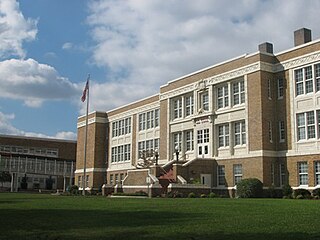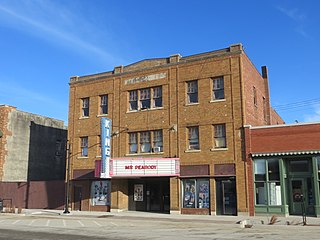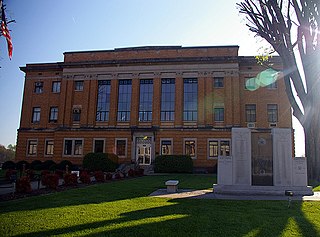
The Depot Historic District is an industrial and commercial neighborhood in downtown Raleigh, North Carolina that was the city's railroad and warehouse distribution hub from the 1850s to 1950s. Located two blocks west of Fayetteville Street and to the north and east of the Norfolk and Southern railroad tracks, the district contains four blocks of 35 brick buildings that date from the 1880s to early 1950s. The district encompasses the southwestern portion of Raleigh's original 1792 town plan and was listed on the National Register of Historic Places in 2002.

The Greyhound Bus Depot is a former Greyhound Lines intercity bus station in Columbia, South Carolina. It is at 1200 Blanding Street in downtown Columbia. The depot was named to the National Register of Historic Places on December 28, 1989. After the bus terminal was closed, the building became a bank. Currently, it is a physician's office.

The Main Street Historic District is a 21-acre (8.5 ha) national historic district located at Marion, McDowell County, North Carolina. It was listed on the National Register of Historic Places in 1991. In 1991, it included 36 buildings deemed to contribute to the historic character of the area and one other contributing site.

William J. Wilkins was an American architect in Florence, South Carolina and in partnership with Joseph F. Leitner in Wilmington, North Carolina.

Marion Historic District is a national historic district located at Marion, Smyth County, Virginia. The district includes 361 contributing buildings, 2 contributing sites, and 1 contributing object in the central business district and surrounding residential areas of Marion. It includes a variety of residential, commercial, institutional, industrial, and governmental buildings primarily dating from the mid-19th to mid-20th centuries. Notable buildings include the Sheffey Loom House, Odd Fellows Lodge, Look & Lincoln Wagon Factory warehouse, the Beaux-Arts style Marion County Courthouse (1905), Mt. Pleasant Methodist Church, Courtview Building (1890s), Marion High School (1907-1908), Marion Junior College (1912), the Overall Factory, Weiler Building, Bank of Marion (1922), Royal Oak Presbyterian Church (1923), Marion Municipal Building (1935), Marion Post Office (1936), and a Lustron house (1948). Also located in the district are the separately listed Hotel Lincoln, Lincoln Theatre, Marion Male Academy, and Norfolk & Western Railway Depot.

Mullins Commercial Historic District is a national historic district located at Mullins, Marion County, South Carolina. The district encompasses 38 contributing buildings in the central business district of Mullins. It includes an intact collection of late 19th and early 20th century commercial and other public buildings. The buildings illustrate the growth and development of Mullins from its beginnings as a railroad town to its prominence as the leading tobacco market in South Carolina for most of the 20th century. The buildings were constructed between 1895 and about 1945, and represent stylistic influences ranging from late Victorian period examples displaying elaborate brick-corbeled cornices and pediments to the more simplified and minimalist Depression-era examples with typical low relief detailing and vertical piers. Notable buildings include the Old Martin Hospital (1937), Vaughan Hotel (1921), Mullins Library (1941), Old Mullins Post Office, Bank of Mullins / Anderson Brothers Bank, and Mullins Depot (1901). Located in the district are the separately listed Old Brick Warehouse and J.C. Teasley House.

Goldston Commercial Historic District is a national historic district located at Goldston, Chatham County, North Carolina. The district encompasses 15 contributing buildings in the central business district of Goldston. The buildings date from about 1890 to 1935 and includes of rows of one and two-story brick flat-roofed commercial buildings. Notable buildings include the Bynum and Paschal Warehouse, the Bynum and Paschal/Second Farmer's Union Company Store, the First Farmer's Union Store, A.J. Goldston General Store, and McLaurin Grocery Store.

Randolph Street Historic District is a national historic district located at Thomasville, Davidson County, North Carolina. The district encompasses 10 contributing buildings in mixed-use area in the city of Thomasville. The contributing buildings include three residences, the Memorial Methodist Church (1951), the Standard Chair Company Building, the Gray Concrete Pipe Company Machine Shop, and the Carolina and Yadkin Valley Railroad Depot (1913).

Wallace Commercial Historic District is a national historic district located at Wallace, Duplin County, North Carolina. The district encompasses 55 contributing buildings in the central business district of Wallace. It primarily includes commercial buildings with notable examples of Queen Anne and Moderne style architecture. Notable buildings include the (former) Wallace Post Office (1940-1941), (former) Farmers Bank & Trust Company (1922), White House Cafe, Wallace Depot and Freight Warehouse, Oscar Rivenbark Wholesale Building, Johnson Cotton Company Building and adjacent Warehouse, Blanchard Pontiac dealership, and the former Robert Carr Gulf Station.

Downtown Sanford Historic District is a national historic district located at Sanford, Lee County, North Carolina. It encompasses 53 contributing buildings in the central business district of Sanford. The district includes notable examples of Colonial Revival, Tudor Revival and Art Deco style architecture, with buildings largely dated between about 1895 to 1930. Located in the district are the separately listed Railroad House and Temple Theatre. Other notable buildings include the Sanford Buggy Company, McCracken Building, Passenger Depot, City Hall, Coca-Cola Bottling Company, Masonic Lodge, Makepeace Building (1924), Wilrick Hotel (1925), Bowers Building, Cole Pontiac Building, Hubbards Shoe Store (1926), Carolina Hotel (1930), and former U. S. Post Office.

Kinston Commercial Historic District is a national historic district located at Kinston, Lenoir County, North Carolina. It encompasses 30 contributing buildings in a mixed commercial and industrial section of Kinston. The district is considered a boundary increase to the previously listed Queen-Gordon Streets Historic District. The buildings include notable examples of Art Deco and Romanesque style architecture and date between 1896 and 1941. Notable buildings include the Carolina Theatre (1935), Cash Supply Store Building, Spence Motor Company Building, and Ellis Carriage Factory (1908-1914).

Old Fort Commercial Historic District is a national historic district located at Old Fort, McDowell County, North Carolina. The district encompasses 11 contributing buildings, 1 contributing structure, and 1 contributing object in the central business district of Old Fort. It includes notable examples of Italianate, Romanesque Revival and Art Moderne architecture built between 1894 and 1960. Notable buildings include the Bank of Old Fort, Rockett Motors, Roxy Theatre, and Railroad Depot (1894).

Main Street Commercial Historic District is a national historic district located at Hamlet, Richmond County, North Carolina. The district encompasses 23 contributing buildings, 3 contributing structures, and 1 contributing object in the central business district of Hamlet. It includes buildings built between about 1900 to about 1940 and notable examples of Queen Anne, Art Deco, and Classical Revival architecture. Located in the district is the separately listed Seaboard Air Line Passenger Depot. Other notable buildings include the Terminal Hotel, Union Building, the Bank of Hamlet (1912), the Old Hamlet Opera House, and the U.S. Post Office (1940), a Works Progress Administration project.

Fairmont Commercial Historic District is a national historic district located at Fairmont, Robeson County, North Carolina. The district encompasses 31 contributing buildings in the central business district of Fairmont. It includes buildings built between about 1898 to 1960 in a variety of popular architectural styles, including Italianate and Modern Movement. Notable buildings include the Rawls Motor Company (1952), McDaniel Hardware, Floyd and Floyd (1960), A. L. Jones Building (1912), Big Brick Warehouse, and Fairmont Depot (1898).

Salisbury Railroad Corridor Historic District is a national historic district located at Salisbury, Rowan County, North Carolina. The district encompasses 37 contributing buildings and 1 contributing site consisting primarily of railroad-related and commercial buildings. It largely developed during the first half of the 20th century, and includes notable examples of Mission Revival style architecture. Located in the district is the separately listed Salisbury Southern Railroad Passenger Depot designed by Frank Pierce Milburn. Other notable buildings include the Cheerwine/Carolina Beverage Corporation Building (1913), Yadkin Hotel (1913), Frick Building, Boyden-Overman Company Cotton Warehouse, and Old Freight Depot.

Clinton Commercial Historic District is a national historic district located at Clinton, Sampson County, North Carolina. The district encompasses 67 contributing buildings and 4 contributing objects in the central business district of Clinton. It developed between about 1902 and 1951, and includes notable examples of Colonial Revival, Tudor Revival, and Classical Revival architecture. Located in the district are the separately listed Bethune-Powell Buildings, Clinton Depot, and Johnson Building. Other notable buildings include the Sampson County Courthouse, Bank of Sampson (1902), Henry Vann Building (1924), William's Building, DuBose Building (1938), and U. S. Post Office (1936) designed by the Office of the Supervising Architect under Louis A. Simon.

Laurinburg Commercial Historic District is a national historic district located at Laurinburg, Scotland County, North Carolina. The district encompasses 51 contributing buildings and 2 contributing structures in the central business district of Laurinburg. They were built between about 1893 and 1953 and include notable examples of Streamline Moderne and Art Deco architecture. Notable buildings include the Central Hotel, McDougald's Furniture Store and Funeral Parlor, Everington's Drug Store, Scotland Pharmacy (1935), U.S. Post Office (1939) designed by the Office of the Supervising Architect under Louis A. Simon and built by the Federal Works Administration, First United Methodist Church (1918), Hammond Company Building, and (former) Winn Dixie Grocery Store (1953).

The Waxhaw Historic District is a national historic district located at Waxhaw, Union County, North Carolina. It encompasses 93 contributing buildings, 3 contributing structures, and 1 contributing object in the central business district and surrounding residential sections of Waxhaw. The district developed between about 1888 and 1940 and includes notable examples of Commercial Style, Queen Anne, and Bungalow / American Craftsman style architecture. Notable buildings include the former Post Office (1905), Harris's store, Tyson Store, A.W. Heath Co. Mill (1905), R.J. Belk Company Store, A.W. Heath Company Stores, Weir Building, Plyler Building, Farmer's Ginning & Trading Company, McDonald Hotel (1912), Waxhaw Presbyterian Church (1929), Duncan McDonald House, and Ralph J. Belk House.

The Belle Plaine Main Street Historic District is a nationally recognized historic district located in Belle Plaine, Iowa, United States. It was listed on the National Register of Historic Places in 2013. At the time of its nomination it contained 63 resources, which included 46 contributing buildings, one contributing structure, and 16 non-contributing buildings. The historic district covers most of the city's central business district. Belle Plaine was laid out in 1862 as a railroad town. The Chicago & North Western Railroad was extended from Cedar Rapids the following year. The commercial district is adjacent to the tracks. A major fire destroyed much of the business district in 1894. Thirty-five buildings in the district were built in the months after the fire.






















